-
Car Reviews
- All reviews
- Midsize SUVs
- Small cars
- Utes
- Small SUVs
- Large SUVs
- Large cars
- Sports SUVs
- Sports cars
- Vans
Latest reviews
- Car News
-
Car Comparisons
Latest comparisons
- Chasing Deals
Toyota’s sporty Camry is no longer available with a V6. That said, the SX hybrid’s sporty suspension performs better than expected with a fuel-sipping powertrain
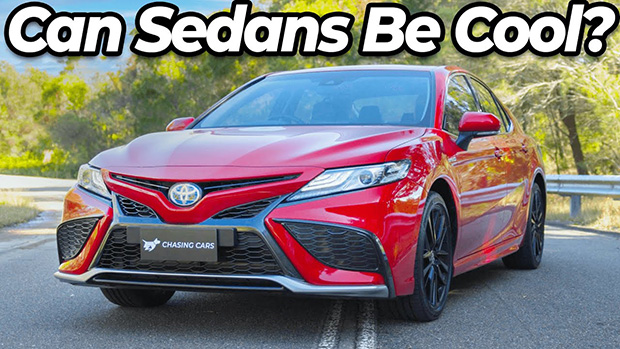
The idea of an athletic Toyota Camry has always existed, with Australian-built wide-body Aurions and Camrys scoring powerful V6s to make them suitably sporty family haulers. In the latest eighth-gen ‘XV70’ Camry, Sportivo was taken off the menu, but the SX arrived on Australian shores in 2018 resplendent with a 224kW V6 option and tauter chassis.
With its new ‘GA-K’ underpinnings, the XV70 SX was finally the fun-to-drive Camry those before wished to be… except the arrival of a mild midlife update in May 2021 marked the end of a 23-year stint of V6 Camrys in Australia.
According to Toyota, this is due to overwhelming demand for the 160kW 2.5-litre petrol-electric hybrid system available in the Camry (now with a lithium-ion battery), where the V6 accounted for a lowly four percent of Aussie sales before its demise.
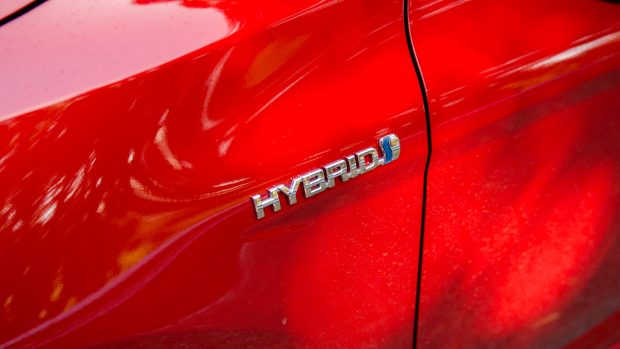
Still, the hybrid has a 64kW deficit to the V6 – a fair drop in grunt – and weight is up, to the tune of 20kg. For a sporty grade, those figures are a big deal, so we wonder if the SX makes any sense when you can get a range-topping SL equipped with heated leather seats, premium sound system and cushier ride for $7830 more, or fabric-seated Ascent Sport for $2900 less.
I’ll first address an initial concern about the SX next to every other Camry: the anticipated loss in ride quality. The sporty suspension tune and upsized 19-inch alloy wheels sounds like a brittle combination – one that shouldn’t really help a family sedan’s chances – yet the SX strikes an excellent balance.
This Camry is never too firm around town owing to high quality dampers, and its low ride height means this Camry is actually very compliant, as it doesn’t need overly firm springs to stop it rolling in corners like an SUV would. There is little fidget or jiggle to the SX’s urban ride, and the tauter control of body movement makes it far less boaty than a marshmallowy Ascent Sport.
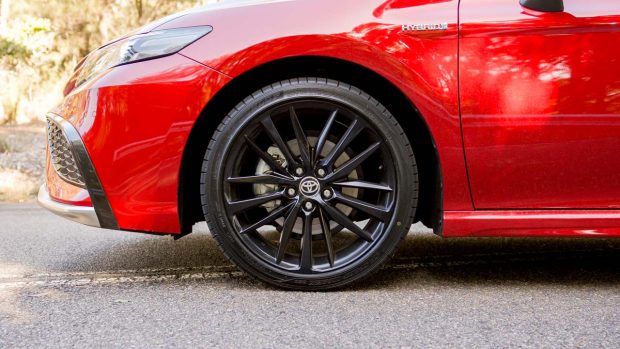
Rolling out of urban environments onto higher speed country roads demonstrates the SX’s crisp steering and great body control. The GA-K underpinnings are good under every car, but it’s clear the SX’s chassis engineers had Akio Toyoda’s declaration of ‘no more boring cars’ in their mind when signing off the Camry SX’s suspension tune.
Putting aside the excellent high- and low-speed ride of the Camry, the truth is that almost all family sedans strike a better balance than SUVs. The Camry’s closest rivals – the Mazda 6, Hyundai Sonata and Honda Accord – are all more rewarding to drive and comfortable than equivalently-sized crossovers.
If all its rivals ride well, then the real reason the Camry outsells the Mazda 6 around 10 to one in Australia is its hybrid powertrain. It’s frugal (I’ll come back to that), but also plenty powerful with 160kW sent to the front wheels, enough to reach 100km/h from rest in 7.77 seconds in our testing.
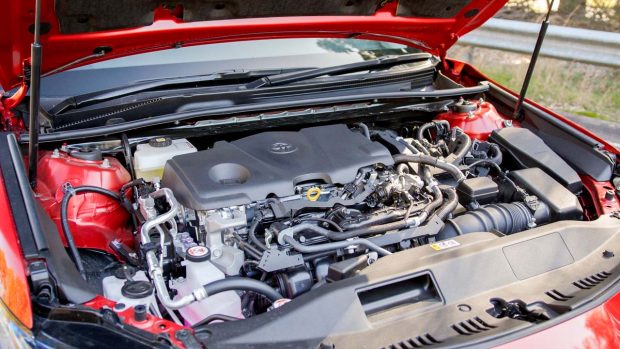
With its electric torque, the Camry’s hybrid system is very refined in everyday use. Toyota’s e-CVT doesn’t need to flare revs to keep up with traffic keeping the Camry experience serene. Even on the highway at a posted 110km/h there was minimal tyre roar from the 235/40 R19 Dunlop Sport Maxx tyres making for a polite cruiser.
What is lacking from the hybrid is the V6’s creamy smoothness, which some people really loved about previous Camrys. When the 2.5-litre petrol engine does kick in, there’s a granularity to its sound and some vibration. Not a deal-breaker, but the new SX isn’t as indulgent as the 3.5-litre V6. Another sore point for the Camry hybrid is its poor 400kg braked towing capacity, only a quarter of what the V6 was able to lug (1600kg).
The updated Camry SX didn’t gain any meaningful safety gear, though it feels like the tuning of adaptive cruise control and lane-keep assist is now more mature than before, if still some way behind Hyundai and Kia’s implementation.
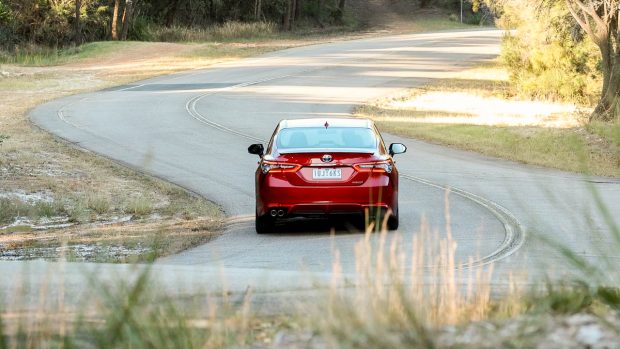
The Camry SX’s 2017 five-star ANCAP rating remains and it has active features including AEB with pedestrian and cyclist detection, front and rear cross-traffic alert, blind-spot monitoring, reverse camera, as well as front and rear parking sensors.
Far from a full facelift, the latest Camry update is minor, with some light massaging to the SX’s sporty fascia enough only for trainspotters to recognise. Inside, the differences are more obvious, with a larger 9.0-inch touchscreen that sits high and proud of the dash.
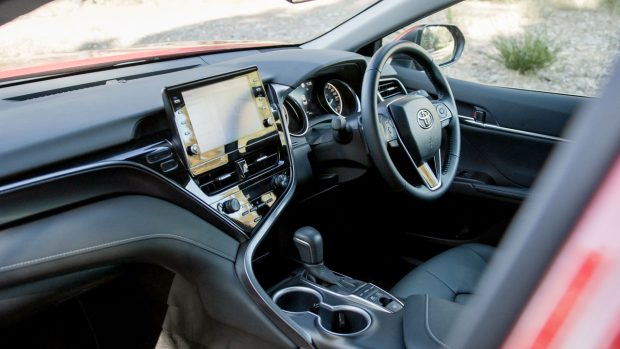
The new screen has higher resolution and is a little more responsive, but Toyota’s graphics still look dated next to Hyundai’s sharper software. Apple CarPlay and Android Auto both still require a cable; reliable but not cutting edge.
Toyota has also added a more comprehensive 7.0-inch TFT screen between two analogue gauges that now persistently shows the car’s speed, where before cycling through screens meant you had to look at the not-so-legible analogue dials. The hybrid Camry does away with a tachometer in favour of an eco-power dial readout.
Moving the touchscreen around thankfully hasn’t compromised Toyota’s good switchgear layout. The HVAC controls are easy to interact with, there’s a physical volume knob, and the USB points are simple to locate. The nice-to-hold leather-appointed steering wheel also has handy shortcut buttons.
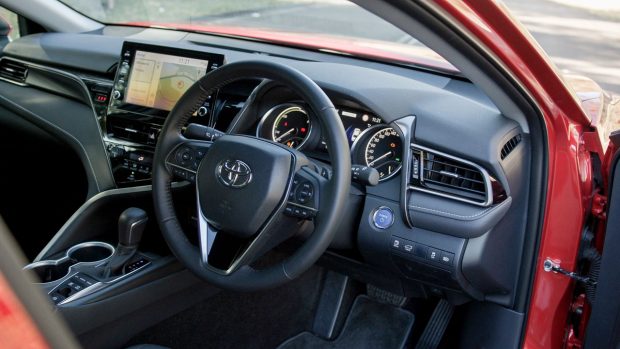
Clever cubbies are found beneath the centre stack where a sliding tray makes for good hidden storage, as does the generous space under the soft armrest. The Camry has two cupholders above the transmission tunnel and well-sized bins in the doors for one litre camping bottles.
Where the SX doesn’t feel so well thought out is the seating. The chairs are fairly comfortable, but the upholstery doesn’t feel as classy as what you’d find in a Mazda 6 or as sporty as a Hyundai Sonata N-Line and also misses the three-stage heating equipped on the $46,990 (before on-road costs) Camry SL. Another reason to cough up the cash for an SL, is the SX’s six-speaker sound system that lacks power and clarity compared to the premium nine-speaker JBL fitted to the SL.
Over our time with the Camry it developed a small rattle somewhere in the dashboard, which runs contrary to the usual belief that Toyota products are excellently built. Apart from that small rattle, though, the Camry’s plastics felt of reasonable quality and construction sturdy.
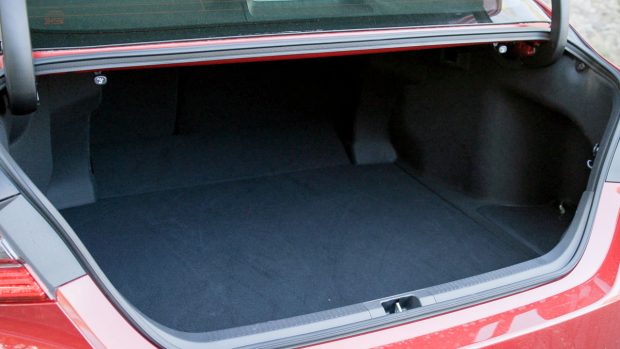
As a popular ride-share choice the Camry’s back seat matters. Like the front quarters there aren’t that many intelligent touches – as a personal pet peeve, the arm rest slumps limply onto the middle seat – but it is spacious and does the job. There are also two adjustable air vents in the SX and the door cards have soft-moulded tops for a hint of extra class.
The boot remains unchanged (and cavernous) at 524 litres. This makes the Camry perfect for airport trips with lots of luggage. The Camry’s boot is compromised in how large an item you can fit in with seats folded due to the bulkhead encroaching, which made it difficult to fit my road bike in the back without taking both wheels off.
In the era of ever-fluctuating fuel prices, having a frugal vehicle is crucial to tempering the cost of living. An EV is the obvious choice, but there are no options that rival a Camry’s space, range and ease of ownership within a $30,000 price radius.
The hybrid SX has a combined ADR consumption figure of 4.7L/100km, slightly worse than the SL’s 4.5L/100km figure likely due to the stickier tyres and larger wheels.
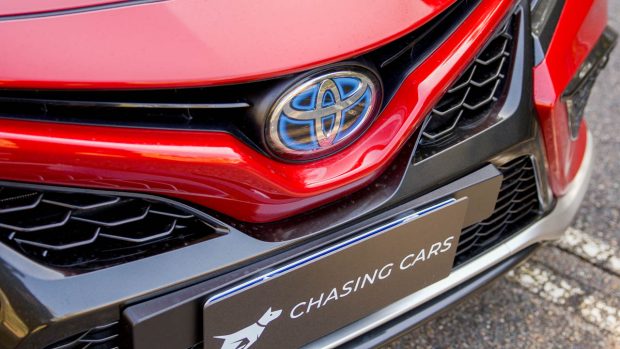
Our real-world test didn’t match the ADR figure, but at 5.6L/100km the Camry SX hybrid was far more efficient than the old V6’s book figure of 8.9L/100km. The Camry hybrid does require more expensive 95 RON premium unleaded petrol.
Servicing is due at industry standard intervals of 12 months/15,000km and is capped for five years. In total, the Camry SX hybrid will only cost $1100 to maintain over a five year/75,000km period, very affordable when compared to a Mazda 6 ($1469) or Hyundai Sonata ($1750).
Toyota’s warranty also matches the industry standard at five years/unlimited kilometres, and while some brands such as Kia (seven years) and Mitsubishi (ten years) offer longer guarantees, neither offers a direct rival for the Camry sedan.
It might seem strange, but with the hybrid engine equipped the Camry SX makes more sense than with the V6 in the current global situation.
The hybrid is not as quick and the four-cylinder combustion engine isn’t as smooth as the V6, but the way Toyota’s hybrid systems sip fuel around town is impressive. The CVT and engine combination is also refined enough to make the Camry a serene sedan.
As much as the SX and hybrid combination sounds almost oxymoronic, the execution is really quite sweet. If only the SX was available with heated seats and the option of a sunroof to combine the sportiness with a hint of added luxury.
Overarchingly, the Camry serves as a reminder to consider something other than an SUV in your next purchase. If you don’t need the ground clearance, the Camry’s excellent ride and dynamic polish means you should at least try one, after all, at time of writing the wait is only 12 months for a hybrid, not the 24 months for an equivalent RAV4.
Variant tested SX HYBRID
Key specs (as tested)
About Chasing cars
Chasing Cars reviews are 100% independent.
Because we are powered by Budget Direct Insurance, we don’t receive advertising or sales revenue from car manufacturers.
We’re truly independent – giving you Australia’s best car reviews.
The estimate provided does not take into account your personal circumstances but is intended to give a general indication of the cost of insurance, in order to obtain a complete quote, please visit www.budgetdirect.com.au. Estimate includes 15%^ online discount.
^Conditions Apply
Budget Direct Insurance arranged by Auto & General Services Pty Ltd ACN 003 617 909(AGS) AFSL 241 411, for and on behalf of the insurer, Auto & General Insurance Company Limited(ABN 42 111 586 353, AFSL 285 571).Because we don’t know your financial needs, we can’t advise you if this insurance will suit you. You should consider your needs and the Product Disclosure Statement before making a decision to buy insurance. Terms and conditions apply.
Indicative quote based on assumptions including postcode , 40 year old male with no offences, licence suspensions or claims in the last 5 years, a NCD Rating 1 and no younger drivers listed. White car, driven up to 10,000kms a year, unfinanced, with no modifications, factory options and/or non-standard accessories, private use only and garaged at night.
^Online Discounts Terms & Conditions
1. Discounts apply to the premium paid for a new Budget Direct Gold Comprehensive Car Insurance, Third Party Property Only or Third Party Property, Fire & Theft Insurance policy initiated online on or after 29 March 2017. Discounts do not apply to optional Roadside Assistance.
2. Discounts do not apply to any renewal offer of insurance.
3. Discounts only apply to the insurance portion of the premium. Discounts are applied before government charges, taxes, levies and fees, including instalment processing fees (as applicable). The full extent of discounts may therefore be impacted.
4. We reserve the right to change the offer without notice.